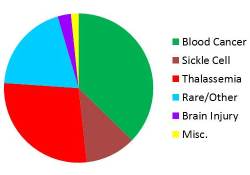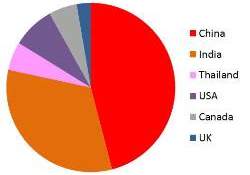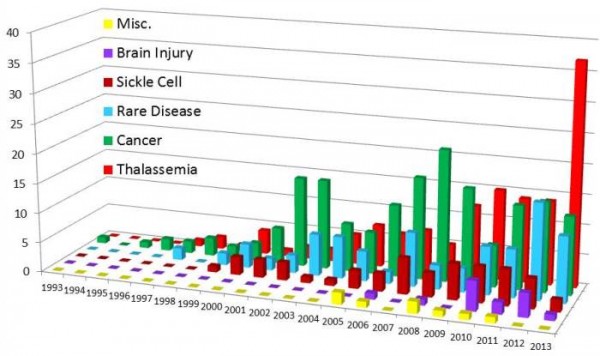Usted está aquí
Sibling Transplants for Thalassemia: Family Banks Fulfill a Public Health Need
 The inaugural Cord Blood Industry Report from the Parent's Guide to Cord Blood Foundation reveals that sibling transplants for thalassemia are becoming the dominant allogeneic therapy with cord blood from family banks. An allogeneic therapy is any therapy where the cord blood is used for a person other than the baby from which it originated. A pie chart of the cumulative allogeneic therapies through the end of 2013 is shown at left.
The inaugural Cord Blood Industry Report from the Parent's Guide to Cord Blood Foundation reveals that sibling transplants for thalassemia are becoming the dominant allogeneic therapy with cord blood from family banks. An allogeneic therapy is any therapy where the cord blood is used for a person other than the baby from which it originated. A pie chart of the cumulative allogeneic therapies through the end of 2013 is shown at left.
Our Cord Blood Inustry Report also finds that most of the growth in sibling transplants for thalassemia is occurring in Asia. Considering the prevalence of thalassemia among populations in Asian nations, coupled with the growth of family cord blood banks in that region, this trend is expected to continue.
Parent's Guide to Cord Blood (PGCB) Foundation is a registered 501(c)(3) charity based in the United States. For over a decade, the PGCB Foundation has been taking confidential surveys of the inventory of cord blood stored in family banks and the number of cord blood therapies released from family banks. These surveys are confidential in the sense that the identity of individual banks and individual patients are not revealed, the data are only reported in anonymous and/or aggregate statistics.
Starting this year, the survey is being published as a subscriber service to a secure website CordBloodIndustryReport.org. A preview of the report was published in Ballen, Verter & Kurtzberg 2015, and a different preview is provided here.
Some cord blood banking statistics across the decade from 2003 to 2013:
| Year | Cumulative 2003 | Cumulative 2013 |
| Worldwide therapies released from family banks | 102 | 1015 |
| Global family therapy division allogeneic/autologous | 93% / 7% | 52% / 48% |
| % Family allogeneic therapies for blood cancers | 53% | 37% |
| % Family allogeneic therapies for hemoglobinopathies | 26% | 39% |
| Ratio of therapies from Public/Family banks | 30 | 35 |
The figure below shows the growth of allogeneic therapies from family cord blood banks versus time. In this graph the therapies are divided by the diagnosis categories: thalassemia, blood cancer, sickle cell, rare disease, brain injury, and miscellaneous. Over the four years concluding in 2013, thalassemia transplants have equaled or exceeded transplants for blood cancers. In 2013 the transplants for thalassemia alone exceeded all other allogeneic therapies combined.
About 15 million people worldwide were sick from thalassemia in 2013, making it a public health issue in those countries with many carriers. Throughout Asia many families carry one of the genetic mutations for thalassemia. In Northern Thailand and Laos, the prevalence of alpha-thalassemia is 40%, while beta-thalassemia varies between 1-9%. The hemoglobin E (HbE) mutation also occurs in 30-40% of this population and reaches 60% prevalence in certain areas of North East India. These abnormal globin genes, present in different combinations, lead to over 60 different thalassemia syndromes. (Manipalviratn et al. Parent's Guide to Cord Blood Nov. 2014 newsletter)
The PGCB Foundation recently contributed to a book titled Stem Cell Banking & Transplantation, in which 49 of the 55 contributors are based in India (editors Dhot, Brig. Dr. PS, Parikh, PM, & Mishra, Col. D. 2015). Current estimates suggest that about 10,000 children are born in India each year with Thalassaemia. (Brig. Dr. Dhot, p.244) "The burden of transfusion and chelation in children with thalassaemia in India is huge and the majority of patients in our country face early death in their teenage years due to cardiac or liver haemosiderosis... With the advent of preimplantation genetic diagnosis and savior siblings to help children with thalassaemia, we do foresee a greater role for the use of cord blood stem cells in this group of children in the coming years." (Dr. Revathi Raj et al., p.235)
 Meanwhile, family cord blood banking has become a routine practice at the private hospitals used by relatively affluent parents throughout Asian nations. China launched a network of state-run public/family (known as the hybrid business model) cord blood banks since 2003, and privately-owned family banks took off in India since 2004. By 2023, India has the world's highest number of births in a nation, at 23.2 million per year, and China is next with 8.9 million.
Meanwhile, family cord blood banking has become a routine practice at the private hospitals used by relatively affluent parents throughout Asian nations. China launched a network of state-run public/family (known as the hybrid business model) cord blood banks since 2003, and privately-owned family banks took off in India since 2004. By 2023, India has the world's highest number of births in a nation, at 23.2 million per year, and China is next with 8.9 million.
India has the world's highest number of annual births, at 24.6 million in 2014, and China is next at 16.5 million ( CIA World Factbook on-line).
If the Thalassemia case reports from family banks over the past ten years of the PGCB confidential survey are separated according to whether they were transplanted in Asia or elsewhere, it is clear that the Asian banks are responsible for the rise in thalassemia transplants.
In recent years the majority of the thalassemia transplants from family banks in the PGCB Foundation survey took place in China and India. This is illustrated in the pie chart to the left, which shows thalassemia transplants for 2013 only, divided by nationality. As of 2014, the PGCB Foundation survey found that 34.6% of the world’s family cord blood inventory is in the nations of Asia & Oceania.
 In summary, it is clear that family and hybrid cord blood banks are becoming an important health resource for families in Asia that carry a thalassemia trait and especially those families who already have a child that is sick with thalassemia. These communities need to also build their inventory of public cord blood donations so that more families can access cord blood transplants as a curative therapy for thalassemia.
In summary, it is clear that family and hybrid cord blood banks are becoming an important health resource for families in Asia that carry a thalassemia trait and especially those families who already have a child that is sick with thalassemia. These communities need to also build their inventory of public cord blood donations so that more families can access cord blood transplants as a curative therapy for thalassemia.
This study demonstrates that family cord blood banks can provide an important public health service in parts of the world where the public banking infrastructure is weak or non-existent.



